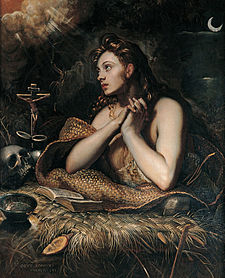St Mary Magdalen
| Mary Magdalene | |
|---|---|

The Penitent Magdalene
by Domenico Tintoretto c. 1598 |
|
| Apostle to the Apostles | |
| Born | (date unknown) unknown; possibly Magdala in Galilee (Roman province of Judea) |
| Died | (date unknown) Place: possibly Saint-Maximin-la-Sainte-Baume, Provence-Alpes-Côte d'Azur, France, or Ephesus, Asia Minor |
| Venerated in |
Eastern Orthodox Church Catholic Church Anglican Communion Lutheranism other Protestant churches Bahá'í Faith |
| Canonized | pre-Congregation |
| Feast | July 22 |
| Attributes |
Western: alabaster box of ointment |
| Patronage | Apothecaries; Kawit, Cavite; Atrani, Italy; Casamicciola Terme, Ischia; contemplative life; converts; glove makers; hairdressers; penitent sinners; people ridiculed for their piety; perfumeries; pharmacists; sexual temptation; tanners; women |
Western: alabaster box of ointment
Mary Magdalene (/ˈmæɡdələn/ Hebrew: מרים המגדלית, original Biblical Greek: Μαρία ἡ Μαγδαληνή), literally translated as Mary the Magdalene or Mary of Magdala or occasionally The Magdalene, was a Jewish woman who, according to texts included in the New Testament, traveled with Jesus as one of his followers. She is said to have witnessed Jesus' crucifixion and resurrection. Within the four Gospels she is named at least 12 times, more than most of the apostles.
The Gospel of Luke says seven demons had gone out of her, and the longer ending of Mark says Jesus had cast seven demons out of her. She is most prominent in the narrative of the crucifixion of Jesus, at which she was present, and the witness in all four gospels of the empty tomb, which is central to narratives of Jesus' resurrection. She was also present two days later, immediately following the sabbath, when, according to all four canonical Gospels, she was, either alone or as a member of a group of women, the first to testify to the resurrection of Jesus.John 20 and Mark 16:9 specifically name her as the first person to see Jesus after his resurrection.
...
Wikipedia
